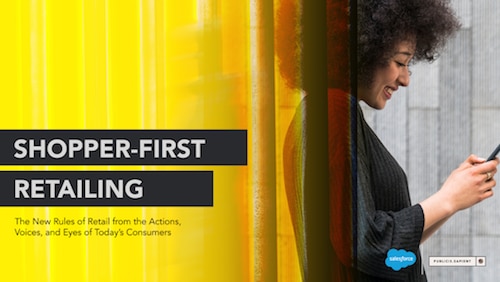Retailers that win in today’s changing retail landscape have put aside what they think they know to listen to what shoppers actually want. Understanding this empowered, connected shopper’s wants and needs should be multifaceted — and that’s why we conducted new, multilayered research to get a true pulse on today’s shopper.
For the second edition of the “Shopper-First Retailing” report, Salesforce and our research partner Publicis.Sapient examined retail’s new rules through three data sources:
- Digital shopping behavior from 500 million shoppers and 1.4 billion ecommerce visits worldwide, and customer service data from 200 million service cases
- Survey of 6,000 consumers across six countries
- In-person mystery shopping assessments of 70 stores across NYC, London, and San Francisco
This new report reveals where and how shoppers are interacting, where they experience the most friction, and what their behaviors mean for retailers. These trends impact every retailer or brand — regardless of size or segment, as shopper choice increasingly dictates the retail landscape.
Hear more insights from Salesforce and Publicis.Sapient researchers now:
 
To summarize, here are five of the primary findings from our research:
1. Brands and marketplaces are squeezing out retailers
We asked consumers, “You’re making a purchase through a brand, retailer, or marketplace. If the price is the same everywhere, why do you choose each channel?” While consumers still prefer retailers for their strong customer service (think Nordstrom and REI), marketplaces and brands beat retailers in every other consumer preference category [CLICK TO TWEET].
Marketplaces received top scores when it comes to price, product variety, product availability, and inspiration. Brands win shoppers’ preference when it comes to product quality, innovation, and uniqueness. Retailers must lean into their service strengths by modernizing tactics through emerging tools like video chat or always-on chatbots. They should also aim to improve shoppers’ perception of product quality and availability.
2. Marketplaces are winning the second purchase and shopper loyalty
Growing loyalty and sustaining a long-term shopper relationship (and revenue stream) is the goal of every retailer and brand. We asked consumers, “Imagine you want to buy something you’ve never bought before. Where are you most likely to go?” Between the choice of retailers, brands, and marketplaces like Amazon, consumers said they made 50% of first-time purchases from retailers, followed by marketplaces (31%) and brands themselves (19%).
We next asked consumers, “Now imagine you want to buy it again. Where are you most likely to go?” This is where the story changes: When it comes to repeat purchases, marketplaces handily beat retailers, with 47% of repeat purchases made on marketplaces, followed by retailers (34%) and brands (20%) [CLICK TO TWEET].
The second purchase is today’s battleground. Agility, loyalty, and personalization are imperative for retailers and brands to differentiate and win the second purchase. Unforgettable experiences and products can’t be commoditized.
3. Shoppers use mobile in-stores at an unprecedented rate — but mobile store experiences lag behind
The brick-and-mortar store is far from passé: 46% of shoppers still prefer to buy in a physical store, vs. 35% for laptops, and 18% for mobile phones.
Additionally, 71% of shoppers say they’re now using their mobile devices in-stores (83% for shoppers aged 18-44) — up from 62% in 2017 [CLICK TO TWEET]. Shopper activities while using mobile in-stores are diverse, from purchasing to reading reviews.
At the same time, in our mystery shopping study, the average mobile score across all stores was just 1.74 out of 5. With a few exceptions, the stores we studied severely lacked mobile CTAs, apps with relevant omnichannel functionalities, and mobile personalization. We advise omni-channel leaders to take better advantage of shoppers’ unprecedented use of mobile in stores by leveraging apps, geofencing, SMS, and social media.
4. Fast retail is here: Shoppers prefer retailers that can move at their speed
Fast fashion only tells part of the story. Our research found that meeting shoppers’ expectations is now about fast retail — offering shopping journeys, transactions, and experiences that move at the speed of the shopper: 69% of consumers say it’s important or very important to see new merchandise each time they visit a store or shopping site.
Additionally, 75% of consumers’ site search queries are brand new each month, showing just how fast consumers are discovering new product types, brands, and features. Within the top 5% of best-selling products on ecommerce sites, the majority of them (59%) change monthly. That means retailers and brands can’t sleep on analyzing shopper searches and delivering the ever-changing items they seek in real time.
On the product side, 59% of shoppers say they’re more likely to buy from brands that offer customized products. Our mystery shopping study noted brands like American Girl, Adidas, and Lacoste offering exclusive personalization that went far beyond the monogram to make shoppers part of the creative process.
5. Leading brands lead with values, personalization, and service
Shoppers reward brands that go beyond transactions, dollar signs, and orders to bring relevance and resonance to the relationship. How do these brands do it? Through values, personalization, and service.
Values: 45% of shoppers are more likely to buy if the retailer/brand gives a charitable donation with their purchase. Additionally, nine of the top-rated 10 brands in our mystery shopping study had above-average scores in creating an emotional connection. Brands like Lush, Everlane, and Life Is Good lead with values — and shoppers are following.
Personalization: 6% of ecommerce visits that include engagement with AI-powered recommendations drive an outsized 37% of revenue. In a landscape where 64% of shoppers say they feel retailers don’t truly know them, AI-driven personalization is a critical tool.
Service: During Cyber Week 2017, shoppers logged five cases for every one knowledge-base view. As Christmas approaches, shoppers seek direct support, but knowledge bases and self-serve options (like forums and chatbots) are increasingly preferred by customers. Empower customers to find their own answers — they’ll take advantage of it.
Focusing on values, personalization, and service makes shoppers’ context relevant and tells them: we’re listening. And in an age of commoditized products and the race to the bottom, that level of listening drives long-term relationships.
Download the full “Shopper-First Retailing” report for more research on shopper expectations for digital and physical shopping journeys, the technologies they prefer, and what it all means for your marketing, commerce, and service strategies.





























